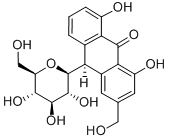Aloin
Synonym(s):1,8-Dihydroxy-10-(β-D -glucopyranosyl)-3-(hydroxymethyl)-9(10H)-anthracenone;10-β-D -Glucopyranosyl-1,8-dihydroxy-3-(hydroxymethyl)-9(10H)-anthracenone;Aloin A;Barbaloin
- CAS NO.:1415-73-2
- Empirical Formula: C21H22O9
- Molecular Weight: 418.39
- MDL number: MFCD00151160
- EINECS: 215-808-0
- SAFETY DATA SHEET (SDS)
- Update Date: 2025-01-27 09:38:02

What is Aloin?
Chemical properties
lemon yellow crystalline powder
The Uses of Aloin
Aloin is a naturally occurring substance found in various Aloe plant species. Aloin was originally used as a laxative in the treatment of constipation. Recent studies have investigated Aloin as an ant ineoplastic agent that enhances melanogenesis and transglutaminase activity.
The Uses of Aloin
Aloe exudant, used as a stimulant-laxative
What are the applications of Application
Aloin is a natural anthracycline isolated from Aloe
Definition
ChEBI: A C-glycosyl compound that is beta-D-glucopyranose in which the anomeric hydroxy group is replaced by a 4,5-dihydroxy-2-(hydroxymethyl)-10-oxo-9,10-dihydroanthracen-9-yl moiety (the 9S d astereoisomer).
Safety Profile
Poison by subcutaneous andintravenous routes. Moderately toxic by ingestion. Whenheated to decomposition it emits acrid smoke and fumes.A carthartic and purgative.
Purification Methods
Aloin forms the monohydrate as lemon yellow crystals on crystallisation from H2O (450g/1.5L) which has a lower m ~70-80o than the anhydrous substance. [Cahn & Simonsen J Chem Soc 2573 1932, Hay & Haynes J Chem Soc 3141 1956.]
Properties of Aloin
| Melting point: | 148°C |
| Boiling point: | 456.17°C (rough estimate) |
| Density | 1.3028 (rough estimate) |
| refractive index | 1.6230 (estimate) |
| storage temp. | Keep in dark place,Inert atmosphere,2-8°C |
| solubility | pyridine: 50 mg/mL, clear, dark red |
| form | neat |
| pka | 7.12±0.40(Predicted) |
| form | Solid |
| color | Yellow needles from EtOH |
| BRN | 6077558 |
| Stability: | Stable, but light sensitive. Incompatible with bases, strong oxidizing agents. Combustible. |
Safety information for Aloin
| Signal word | Warning |
| Pictogram(s) |
 Exclamation Mark Irritant GHS07 |
| GHS Hazard Statements |
H302:Acute toxicity,oral |
Computed Descriptors for Aloin
| InChIKey | AFHJQYHRLPMKHU-WEZNYRQKSA-N |
New Products
Methyl (R)-1-Boc-4,4-difluoropyrrolidine-2-carboxylate 2,2-Difluoropropylamine hydrochloride tert-butyl 3-bromoazetidine-1-carboxylate (R)-1-Boc-3-hydroxypyrrolidine DIFLUOROACETIC ANHYDRIDE 2,2-Difluoropropionic acid Diallylamine, 99% Calcium hydroxide, 95% Aluminum oxide, basic 2-Bromophenylacetonitrile, 97% L-tert-Leucine,97% N-Hydroxy-2-methylpropanimidamide 4-(3,4-Dichlorophenyl)-3,4-Dihydro-N-Methyl-1-(2H)-Naphthalenimine (Schiff Base) 2-AMINO-3,5-DIBROMO BENZALDEHYDE [ADBA] L-Glutamic Acid Dimethyl Ester Hcl 10-Methoxy-5H-dibenz[b,f]azepine 5-Cyanophthalide N, N-Carbonyldiimidazole (CDI) Dibenzoyl Peroxide Titanium Dioxide 2-(Methylthio) Benzonitrile Sodium Acetate Anhydrous Allopurinol 1,5-DibromopentaneRelated products of tetrahydrofuran








You may like
-
 Aloin 98% CAS 1415-73-2View Details
Aloin 98% CAS 1415-73-2View Details
1415-73-2 -
 Aloin CAS 1415-73-2View Details
Aloin CAS 1415-73-2View Details
1415-73-2 -
![Cis-2-(Bromomethyl)-2-(2,4-Dichlorophenyl)-1,3-Dioxolane-4-Ylmethyl Benzoate [CBB] 61397-56-6 99%](https://img.chemicalbook.in//Content/image/CP5.jpg) Cis-2-(Bromomethyl)-2-(2,4-Dichlorophenyl)-1,3-Dioxolane-4-Ylmethyl Benzoate [CBB] 61397-56-6 99%View Details
Cis-2-(Bromomethyl)-2-(2,4-Dichlorophenyl)-1,3-Dioxolane-4-Ylmethyl Benzoate [CBB] 61397-56-6 99%View Details
61397-56-6 -
 Ethyl-2-Chloroacetoacetate 609-15-4View Details
Ethyl-2-Chloroacetoacetate 609-15-4View Details
609-15-4 -
 CIS- BROMO BENZOATEView Details
CIS- BROMO BENZOATEView Details
61397-56-6 -
 609-15-4View Details
609-15-4View Details
609-15-4 -
![1-(6-Methylpyridin-3-Yl)-2-[4-(Methylsulfonyl)Phenyl]Ethanone [Ketosulfone] 99%](https://img.chemicalbook.in//Content/image/CP5.jpg) 1-(6-Methylpyridin-3-Yl)-2-[4-(Methylsulfonyl)Phenyl]Ethanone [Ketosulfone] 99%View Details
1-(6-Methylpyridin-3-Yl)-2-[4-(Methylsulfonyl)Phenyl]Ethanone [Ketosulfone] 99%View Details
221615-75-4 -
 27143-07-3View Details
27143-07-3View Details
27143-07-3
